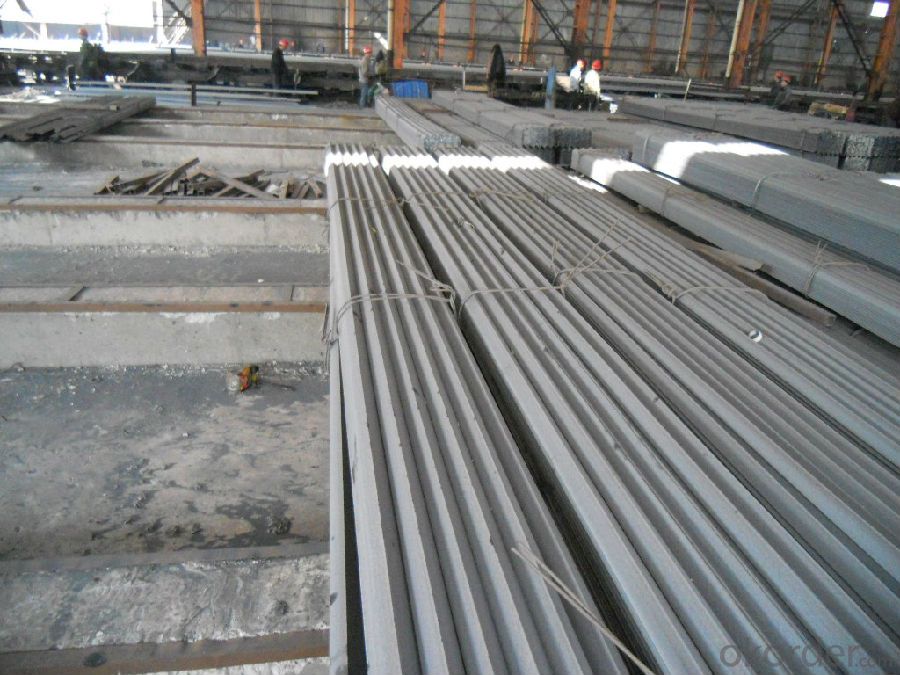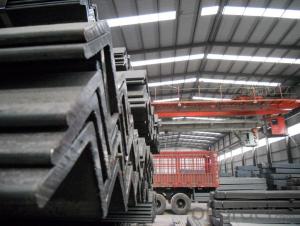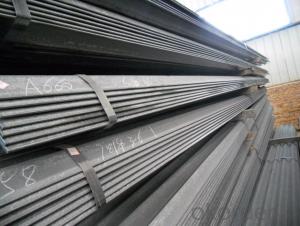Hot Rolled Equal Angle
- Loading Port:
- China Main Port
- Payment Terms:
- TT or LC
- Min Order Qty:
- -
- Supply Capability:
- -
OKorder Service Pledge
OKorder Financial Service
You Might Also Like
Product Description:
OKorder is offering Structure Steel Hot Rolled Angle Bar at great prices with worldwide shipping. Our supplier is a world-class manufacturer of steel, with our products utilized the world over. OKorder annually supplies products to European, North American and Asian markets. We provide quotations within 24 hours of receiving an inquiry and guarantee competitive prices.
Product Applications:
Trusses;
Transmission towers;
Telecommunication towers;
Bracing for general structures;
Stiffeners in structural use.
Product Advantages:
OKorder's Structure Steel Hot Rolled Angle Bar are durable, strong, and resist corrosion.
Main Product Features:
· Premium quality
· Prompt delivery & seaworthy packing (30 days after receiving deposit)
· Corrosion resistance
· Can be recycled and reused
· Mill test certification
· Professional Service
· Competitive pricing
Product Specifications:
1.Standards:GB,ASTM,BS,AISI,DIN,JIS
2.Invoicing on theoretical weight or actual weight as customer request
3.Material: JIS G3192,SS400;SS540.
4. Payment terms:
1).100% irrevocable L/C at sight.
2).30% T/T prepaid and the balance against the copy of B/L.
3).30% T/T prepaid and the balance against L/C
5.Sizes:

5. Material Specifications:
Grade | Yield Strength,N/mm² | Extension Strength N/mm² | |||
Thickness of Steel,mm | |||||
≦16 | >16-≦40 | >40-≦100 | >100 | ||
SS330 | ≧205 | ≧195 | ≧175 | ≧165 | 330-430 |
SS400 | ≧245 | ≧235 | ≧215 | ≧205 | 400-510 |
SS490 | ≧285 | ≧275 | ≧255 | ≧245 | 490-610 |
SS540 | ≧400 | ≧390 | - | - | ≧540 |
Packaging & Delivery of Angle Steel
1. Transportation: the goods are delivered by truck from mill to loading port, the maximum quantity can be loaded is around 40MTs by each truck. If the order quantity cannot reach the full truck loaded, the transportation cost per ton will be little higher than full load.
2. With bundles and load in 20 feet/40 feet container, or by bulk cargo, also we could do as customer's request.
3. Marks:
Color mark: There will be color marking on both end of the bundle for the cargo delivered by bulk vessel. That makes it easily to distinguish at the destination port.
Tag mark: There will be tag mark tied up on the bundles. The information usually including supplier logo and name, product name, made in China, shipping marks and other information request by the customer.
If loading by container the marking is not needed, but we will prepare it as customer request.
Production flow of Angle Steel
Material prepare (billet) —heat up—rough rolling—precision rolling—cooling—packing—storage and transportation
FAQ:
Q1: Why buy Materials & Equipment from OKorder.com?
A1: All products offered byOKorder.com are carefully selected from China's most reliable manufacturing enterprises. Through its ISO certifications, OKorder.com adheres to the highest standards and a commitment to supply chain safety and customer satisfaction.
Q2: How do we guarantee the quality of our products?
A2: We have established an advanced quality management system which conducts strict quality tests at every step, from raw materials to the final product. At the same time, we provide extensive follow-up service assurances as required.
Q3: How soon can we receive the product after purchase?
A3: Within three days of placing an order, we will begin production. The specific shipping date is dependent upon international and government factors, but is typically 7 to 10 workdays.
Q4: What makes stainless steel stainless?
A4: Stainless steel must contain at least 10.5 % chromium. It is this element that reacts with the oxygen in the air to form a complex chrome-oxide surface layer that is invisible but strong enough to prevent further oxygen from "staining" (rusting) the surface. Higher levels of chromium and the addition of other alloying elements such as nickel and molybdenum enhance this surface layer and improve the corrosion resistance of the stainless material.
Q5: Can stainless steel rust?
A5: Stainless does not "rust" as you think of regular steel rusting with a red oxide on the surface that flakes off. If you see red rust it is probably due to some iron particles that have contaminated the surface of the stainless steel and it is these iron particles that are rusting. Look at the source of the rusting and see if you can remove it from the surface.
Images:


- Q:What is the angle iron back machine?
- With the development of the power industry, the manufacturing level of the power tower is becoming more and more demanding, and the planer processing method can not meet the requirements of production. The company's own design and manufacture of "CB2512" shovel back machine, the use of high-speed milling principle, used for angle steel shovel back process, the tower is the production of angle steel shovel back the first choice of equipment
- Q:How do steel angles behave under seismic forces?
- The behavior of steel angles under seismic forces varies depending on their design, size, and connection details. Generally, steel angles are commonly utilized in seismic-resistant structures because they can dissipate energy and withstand lateral forces. Here are several important characteristics regarding the behavior of steel angles under seismic forces: 1. Ductility: Steel angles possess a high level of ductility, allowing them to undergo significant deformations without failure. This characteristic is crucial in seismic design as it enables the structure to absorb and dissipate energy during an earthquake, thereby preventing sudden collapse. 2. Flexibility: Steel angles have the ability to flex and bend when subjected to seismic forces, which enables them to absorb energy and minimize the impact on the overall structure. This flexibility aids in distributing the seismic forces evenly throughout the structure, reducing localized damage. 3. Connection behavior: Proper connection design is vital to ensure the performance of steel angles under seismic forces. The connections must be designed to allow for rotation and accommodate the anticipated displacements during an earthquake. Adequate connections prevent the angles from becoming brittle or failing prematurely. 4. Buckling resistance: Steel angles are prone to buckling under compression forces. To enhance their resistance to buckling, lateral bracing or stiffeners are often utilized. These components offer additional support to the angles and help prevent buckling during seismic events. 5. Strength and stiffness: Steel angles possess high strength and stiffness, enabling them to withstand the lateral forces induced by an earthquake. The strength of steel angles can be enhanced by selecting appropriate materials, such as using higher-grade steel with greater yield strength. In conclusion, steel angles are well-suited for seismic-resistant structures due to their ductility, flexibility, and strength. However, their behavior under seismic forces is heavily dependent on proper design, connection details, and adherence to seismic codes and standards. It is crucial to consult with structural engineers and follow best practices to ensure the optimal performance of steel angles in seismic design.
- Q:Can steel angles be used for stairs?
- Yes, steel angles can be used for stairs. Steel angles are commonly used in the construction industry for various purposes, including staircases. They are often used as the structural support for stair treads and risers. Steel angles provide strength and stability to the stairs, making them a popular choice in both residential and commercial buildings. Additionally, steel angles can be easily customized and fabricated to meet specific design requirements, making them versatile for stair construction.
- Q:How do steel angles perform in terms of impact resistance?
- Steel angles generally perform well in terms of impact resistance. Due to their structural design, steel angles are able to withstand high impact forces and distribute them evenly across their length. This makes them suitable for applications where impact or dynamic loads are expected, such as in construction, industrial machinery, or automotive frames. The high strength and toughness of steel also contribute to its excellent impact resistance. Steel angles are typically made from low carbon steel or alloy steel, which are known for their high tensile strength and ability to absorb energy without fracturing. This enables steel angles to resist deformation and maintain their structural integrity even under heavy impact. Furthermore, steel angles can be further improved in terms of impact resistance by using specific steel grades or by applying surface treatments such as galvanization or powder coating. These treatments can enhance the corrosion resistance and overall durability of steel angles, making them even more resistant to impact and other harsh environmental conditions. However, it is important to note that the specific impact resistance of steel angles can vary depending on factors such as the dimensions, thickness, and material properties of the angle. Therefore, it is recommended to consult with a structural engineer or refer to technical specifications provided by manufacturers to ensure that the steel angle chosen is suitable for the intended application and expected impact loads.
- Q:What are the different types of steel angles connections for columns?
- There are several different types of steel angle connections that can be used for columns in construction. 1. Bolted Angle Connection: This is a commonly used connection where steel angles are bolted together to form a joint. The angles are usually attached to the column using bolts and plates, providing a strong and reliable connection. 2. Welded Angle Connection: In this type of connection, the steel angles are welded directly to the column. Welded connections offer excellent strength and stiffness, making them suitable for heavy-duty applications. 3. Gusset Plate Connection: A gusset plate is a flat plate that is attached to the column and the steel angles to form a connection. The gusset plate is usually bolted or welded to provide additional strength and stability. 4. Cleat Connection: A cleat is a small piece of steel that is bolted or welded to the column and the steel angles. Cleat connections are commonly used for smaller columns and provide a simple and cost-effective solution. 5. Moment Connection: A moment connection is designed to resist both axial and bending loads. It involves welding or bolting steel angles to the column, along with additional reinforcing plates and stiffeners to provide the required strength and rigidity. 6. Eccentric Connection: An eccentric connection is used when the load is applied off-center to the column. It involves attaching the steel angles to the column at an offset position to account for the eccentric load. Overall, the choice of steel angle connection for columns depends on factors such as the load requirements, structural design, and construction methods. It is important to consider the specific needs of the project and consult with a structural engineer to determine the most appropriate connection type.
- Q:How do steel angles perform under dynamic or cyclic loading conditions?
- Steel angles are widely used in structural applications, where they are exposed to dynamic or cyclic loading conditions. These conditions allow the angles to demonstrate their excellent performance due to their inherent properties. First and foremost, steel angles possess remarkable strength and stiffness, enabling them to withstand varying loads and maintain their structural integrity. This ensures that the angles do not deform or fail prematurely when subjected to cyclic loading conditions. Moreover, steel angles exhibit excellent fatigue resistance, meaning they can endure repeated loading and unloading cycles without suffering significant degradation in their mechanical properties. This is possible because the material has the ability to distribute and dissipate stress, preventing the accumulation of fatigue damage. Furthermore, steel angles have the advantage of effectively absorbing and distributing energy. This characteristic aids in reducing the impact of dynamic loads, such as vibrations or sudden impacts, and prevents the formation of localized stress concentrations that could lead to failure. Additionally, steel angles possess high ductility, allowing them to undergo plastic deformation without fracturing. This characteristic is crucial in dynamic loading conditions as it enables the angles to absorb energy and undergo deformation, thereby dissipating the applied loads and reducing the risk of sudden failure. To conclude, steel angles exhibit exceptional performance under dynamic or cyclic loading conditions. Their high strength, stiffness, fatigue resistance, energy absorption capacity, and ductility make them reliable and durable structural elements in various applications where they are subjected to dynamic or cyclic loads.
- Q:What are the dimensions of a standard steel angle?
- The specific requirements and standards determine the dimensions of a standard steel angle, which can vary. Generally, it is a structural steel member in an L shape with legs that may be equal or unequal. The standard dimensions usually encompass the overall length, width, and thickness. For instance, one might find a standard steel angle with an overall length of 20 feet, a width of 2 inches, and a thickness of 1/4 inch. Nevertheless, it is crucial to acknowledge that the dimensions may differ depending on the specific application and industry standards.
- Q:What's the chemical reaction between stainless steel and galvanized angle iron?
- They are not the two reaction, after they are Unicom, there can be electronic flow, and zinc than iron lively, so galvanized angle iron is more likely to be corrosion (mainly air oxidation).
- Q:What are the different methods of surface painting for steel angles?
- There are several different methods of surface painting for steel angles, including brush painting, spray painting, and powder coating. Brush painting involves applying paint directly onto the surface using a brush or roller. Spray painting uses a paint gun to evenly distribute paint onto the surface. Powder coating involves applying a dry powder to the steel angle and then curing it in a high-temperature oven, resulting in a durable and long-lasting finish.
- Q:What are the advantages of using steel angles in construction?
- There are several advantages of using steel angles in construction: 1. Strength and durability: Steel angles are known for their high tensile strength, making them an ideal choice for construction projects that require structural support. They can withstand heavy loads and provide stability, ensuring the longevity and safety of the structure. 2. Versatility: Steel angles come in various sizes and dimensions, allowing for flexibility in design and construction. They can be easily cut, welded, and shaped to fit specific requirements, making them suitable for a wide range of applications. 3. Cost-effective: Steel angles are relatively inexpensive compared to other building materials, such as concrete or wood. They offer a cost-effective solution without compromising on quality or structural integrity. 4. Fire resistance: Steel angles have excellent fire resistance properties, making them a safer choice for construction. In the event of a fire, steel angles will not burn, warp, or emit toxic fumes, reducing the risk of structural collapse and providing more time for evacuation. 5. Sustainable and eco-friendly: Steel is one of the most recycled materials in the world. Using steel angles in construction promotes sustainability and reduces the demand for new steel production. Additionally, steel is 100% recyclable, ensuring minimal environmental impact. 6. Easy installation: Steel angles are lightweight and easily transported to the construction site, making them convenient for installation. Their ease of handling and quick assembly can help reduce construction time and labor costs. 7. Resistance to corrosion: Steel angles can be treated with protective coatings, such as galvanization, to enhance their resistance to corrosion. This ensures that the structure remains durable and maintains its structural integrity even in harsh environmental conditions. Overall, the advantages of using steel angles in construction include their strength, versatility, cost-effectiveness, fire resistance, sustainability, easy installation, and resistance to corrosion. These qualities make steel angles a popular choice for various construction projects, ranging from residential buildings to large industrial structures.
1. Manufacturer Overview |
|
|---|---|
| Location | |
| Year Established | |
| Annual Output Value | |
| Main Markets | |
| Company Certifications | |
2. Manufacturer Certificates |
|
|---|---|
| a) Certification Name | |
| Range | |
| Reference | |
| Validity Period | |
3. Manufacturer Capability |
|
|---|---|
| a)Trade Capacity | |
| Nearest Port | |
| Export Percentage | |
| No.of Employees in Trade Department | |
| Language Spoken: | |
| b)Factory Information | |
| Factory Size: | |
| No. of Production Lines | |
| Contract Manufacturing | |
| Product Price Range | |
Send your message to us
Hot Rolled Equal Angle
- Loading Port:
- China Main Port
- Payment Terms:
- TT or LC
- Min Order Qty:
- -
- Supply Capability:
- -
OKorder Service Pledge
OKorder Financial Service
Similar products
New products
Hot products
Related keywords


























